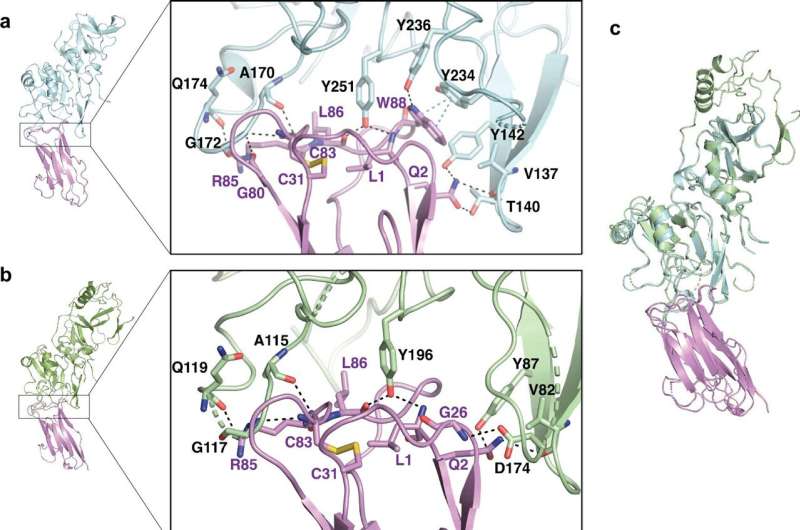This article has been reviewed according to Science X's editorial process and policies. Editors have highlighted the following attributes while ensuring the content's credibility:
fact-checked
peer-reviewed publication
trusted source
proofread
Antibody-like molecule shows promise for broad-spectrum malaria therapy

Scientists at La Trobe University have discovered a new antibody-like molecule that could be used in therapy to prevent infection from multiple malaria parasite species.
The research, recently published in Nature Communications, found that when the molecule WD34 binds with a protein produced by malaria parasites, it inhibits their ability to infect cells at different stages of the disease.
Led by Professor Michael Foley, Professor Robin Anders and Ph.D. candidate Dimuthu Angage at the La Trobe Institute for Molecular Science (LIMS), the research also showed that WD34 can protect against several different malaria parasite species.
Professor Foley said the discovery of WD34 was a significant breakthrough in the fight against malaria, which annually infects more than 240 million people worldwide and was responsible for more than half a million deaths.
"Malaria remains a deadly parasitic disease across the globe, despite extensive eradication efforts," Professor Foley said.
"We urgently need broader therapeutic options to combat drug resistance and treatment failures, and this discovery provides some hope for the development of a treatment for all malaria parasite species."
WD34 is one of several types of infection-fighting "i-bodies" developed by Professor Foley.
In this research, they discovered that it bound with a protein known as AMA1, which is common to many malaria parasite species and is one of two proteins that play a critical role in infection.
When malaria parasites are injected into the bloodstream via a bite from an infected mosquito, they travel to the liver to mature inside the organ's cells.
Around seven days later, they re-enter the bloodstream to infect red blood cells.
To enter both liver and red blood cells, the parasites produce AMA1 along with another protein called RON2. These then bind together to form a chemical mechanism that prizes open the cell walls, allowing the parasite to enter and flourish.
To combat this, Angage developed a new antibody-screening method to sift through their i-body library in search of a molecule which could bind with various strains of AMA1.
They found that the i-body WD34 binds with AMA1 in the same place as RON2, effectively blocking the chemical mechanism.
They also found that WD34 worked with the AMA1 produced by many different species, making it a good candidate for vaccine development to protect against several types of malaria parasites.
Professor Foley said that while AMA1 was a polymorphic antigen—meaning that each strain had a different form—the region where the protein bound with RON2 was the same regardless of the AMA1 strain.
"The AMA1 variations between parasite species have in the past hindered efforts to find a broad-spectrum vaccine. That's why identifying WD34 is such an important breakthrough, as it targets this conserved region and can bind with the various versions of AMA1 produced by different malaria parasite species," Professor Foley said.
WD34 is currently undergoing pre-clinical trials and has so far yielded promising results as a potential shield against malaria.
"Recently, two vaccines targeting the deadliest strain of malaria were introduced. But with the rise of drug-resistant parasites and insecticide-resistant mosquitoes, it's not enough," Professor Foley said.
"WD34 offers hope by opening new avenues of research to develop a vaccine which targets all malaria species."
The preclinical trials have also shown that WD34 could be used to protect against other parasitic diseases with a similar profile.
The antibody screening method developed by Angage for this study is also being tested to see if it can be used to research other infectious diseases.
More information: Dimuthu Angage et al, A broadly cross-reactive i-body to AMA1 potently inhibits blood and liver stages of Plasmodium parasites, Nature Communications (2024). DOI: 10.1038/s41467-024-50770-7
Journal information: Nature Communications
Provided by La Trobe University


















